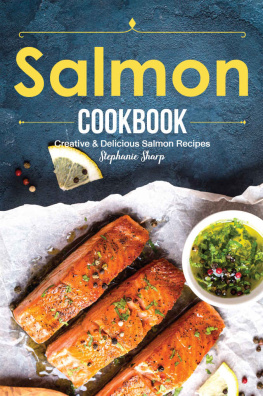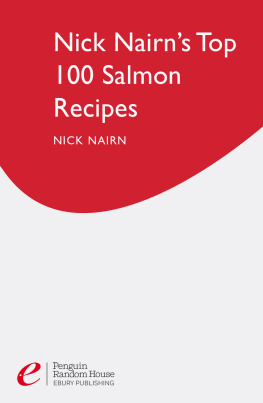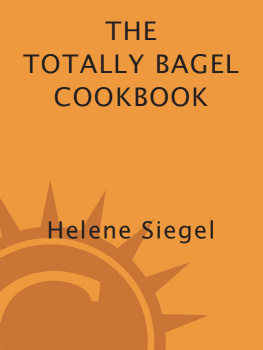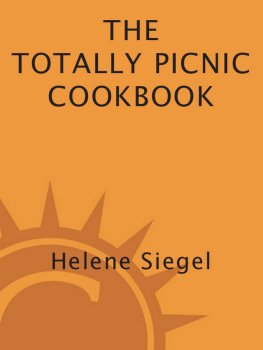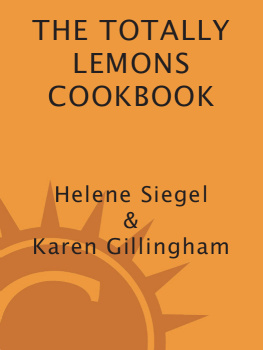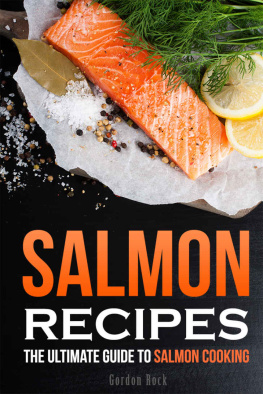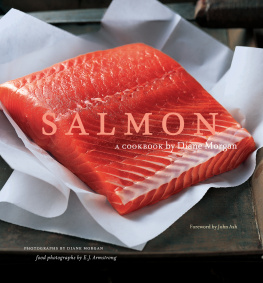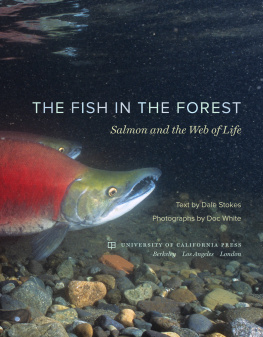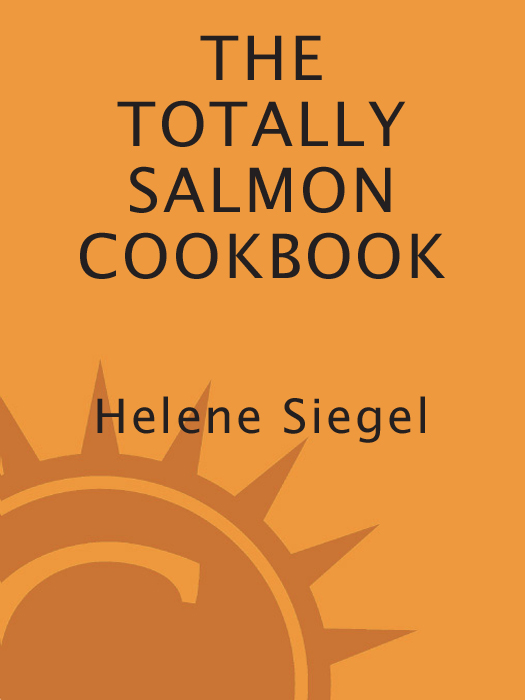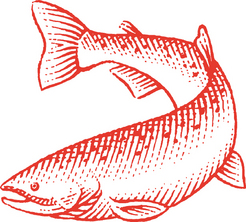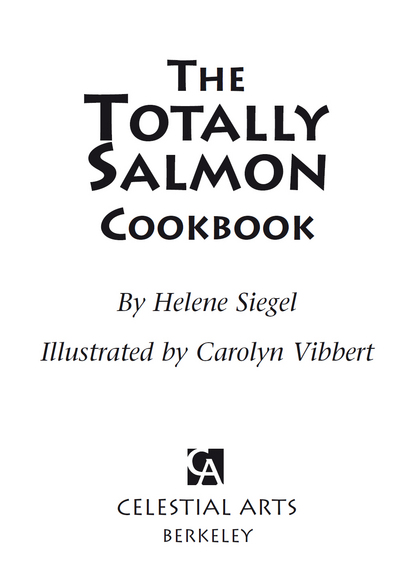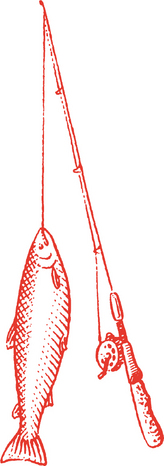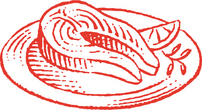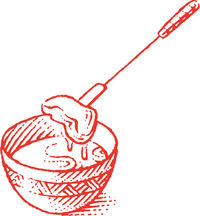Copyright 1997 by Helene Siegel
Illustrations copyright 1997 by Carolyn Vibbert All rights reserved. Published in the United States by Celestial Arts, an imprint of the Crown Publishing Group, a division of Random House, Inc., New York.
www.crownpublishing.com
www.tenspeed.com Celestial Arts and the Celestial Arts colophon are registered trademarks of Random House, Inc.
The Totally Salmon Cookbook is produced by becker&mayer!, Ltd. Library of Congress Cataloging-in-Publication Data
Siegel, Helene.
The Totally Salmon Cookbook / by Helene Siegel.
p. cm.
1. Cookery (Salmon) I.
Title.
TX748.S24S54 1996
641.692dc20 96-36393 ISBN-13: 978-0-89087-824-8
eBook ISBN: 978-0-8041-5311-9 Illustration by Dick Witt
Interior design by Susan Hernday
Interior illustrations by Carolyn Vibbert v3.1 T O SEAFOOD LOVERS EVERYWHERE
Contents
INTRODUCTION
S almon is an easy fish to love. It is available 12 months a year at the supermarket counter, and the quality is consistent. For the health-conscious, it is high in protein, low in carbohydrates, and contains very little saturated fat. On the other hand, it is high in omega-3 polyunsaturated fatthe kind that actually cleans arteries rather than clogging them. For the home cook, salmon is an excellent choice for entertaining. Even finicky fish eaters, including children, tend to like salmons smooth, delicate, pink flesh.
And a note of luxury is often associated with serving salmon, fresh or smoked. Whether you serve it hot or cold, gussied up with extravagant sauces for honored guests or cooked simply under the broiler or on the grill with nothing more elaborate than salt, pepper, and lemon juicesalmon always feels special. If ever a fish deserved a book of its own, its salmon. Types of SalmonThere are two types of salmon: A TLANTIC and P ACIFIC . These days all commercial Atlantic salmon is farm-raised and what wild salmon we see at the market is from the Pacific, primarily from Alaska. Of Pacific salmon there are five varieties: C HINOOK or K ING , the largest of the Pacific salmon and the least abundant commercial catch, can grow to 20 pounds.
Its flesh is extremely fatty (and therefore tasty). When it appears at the market it is often identified according to river of origin. S OCKEYE or RED grows to about 6 pounds and is the most valuable on the world market. Its deep red flesh is especially prized in Japan. C OHO or SILVER is farm-raised in Chile, the United States, and Canada, and grows from 10 ounces to about 10 pounds. P INK or HUMPBACK is a small 4-pound salmon popular in Asia and used primarily for canning in the U.S. (All of the skin and bone in canned salmon can not only be eaten, but are also high in vitamins and minerals, especially calcium.)
ELEGANT FIRSTS
POTATO PANCAKE WITH SMOKED SALMONA crisp, flat potato pancake contrasts nicely with silky strips of salmon in this lovely small meal or appetizer. 2 baking potatoes, peeled and finely shredded teaspoon salt freshly ground pepper cup vegetable oil pound thinly sliced smoked salmon 2 tablespoons sour cream Combine the potatoes, salt, and pepper in a bowl. 2 baking potatoes, peeled and finely shredded teaspoon salt freshly ground pepper cup vegetable oil pound thinly sliced smoked salmon 2 tablespoons sour cream Combine the potatoes, salt, and pepper in a bowl.
Squeeze out excess water and drain. Heat 2 tablespoons of the oil in a large nonstick or cast-iron skillet over medium-high heat. Using a spatula, spread the potatoes in a single layer in the pan. Fry until bottom is golden brown, about 7 minutes, and transfer with spatula to platter. Carefully turn over and slide pancake back into pan, crisp-side up. Fry until second side is crisp and golden brown, 7 minutes longer.
Slide onto serving platter and sprinkle with salt. To serve, cut into six wedges and place a thin slice of salmon on each. Dot with a teaspoonful of sour cream. Serve warm. S ERVES 4 How to Shop for SalmonWhen shopping for whole fish look for bright red blood, thick belly flaps, clear eyes, clean fragrance, and even scale coverage if the scales have not been removed. Wild salmon from the Copper or Yukon rivers in Alaska, available during the summer months, are considered the best.
The key to cooking consistently good seafood is to find a reliable local fish market and cook the fish within hours of bringing it home. PROVENAL SALMON SKEWERSThese no-fuss skewers of fish and vegetables are perfect for summer entertaining. 10 ounces skinless salmon fillet, cut in 1-inch cubes 4 small zucchini, trimmed, skin on, cut in -inch slices 20 cherry tomatoes, stemmed cup olive oil 6 tablespoons lemon juice 5 sprigs rosemary leaves, chopped salt and freshly ground pepper cold mayonnaise for dipping Thread eight skewers with alternating chunks of salmon, zucchini, and tomato. Whisk together olive oil, lemon juice, rosemary, salt, and pepper in large glass or ceramic dish. Add skewers, turn to coat evenly, and marinate in the refrigerator hour. Preheat grill or broiler and rub grate with oil.
Remove skewers from the marinade and evenly season with salt and pepper. Grill or broil 5 to 6 minutes total, turning frequently and brushing with marinade. Serve hot or at room temperature with mayonnaise for dipping. S ERVES 4 SCANDINAVIAN SALMON SOUPHere is a thick, wintry soup for those times when you need a little salmon to go a long way. 2 tablespoons butter 1 onion, sliced 1 cup thinly sliced mushrooms salt and freshly ground pepper 4 cups fish or chicken stock 2 pounds (4 large) boiling potatoes, in chunks 1 cup milk pound skinless salmon fillet, in -inch cubes cup chopped fresh dill 2 tablespoons Dijon mustard Melt the butter in a stockpot over medium heat. Cook the onion and mushrooms with salt and pepper until soft.
Pour in stock and bring to a boil. Add potatoes, bring back to a boil, reduce to a simmer, and cook, uncovered, 30 minutes. Transfer to a food processor or blender and pure in batches. Pour back into the pot and add milk. Bring to a low boil. Stir in salmon, dill, and mustard.
Season to taste with salt and pepper and simmer 5 minutes. Serve hot. S ERVES 8
TEQUILA GRAVLAX







![Mila Mason - Salmon 365: Enjoy 365 Days With Amazing Salmon Recipes In Your Own Salmon Cookbook! (Best Seafood Cookbook, Seafood Soup Cookbook, Seafood Cookbook For Beginners, Grilled Seafood Cookbook) [Book 1]](/uploads/posts/book/288400/thumbs/mila-mason-salmon-365-enjoy-365-days-with.jpg)
